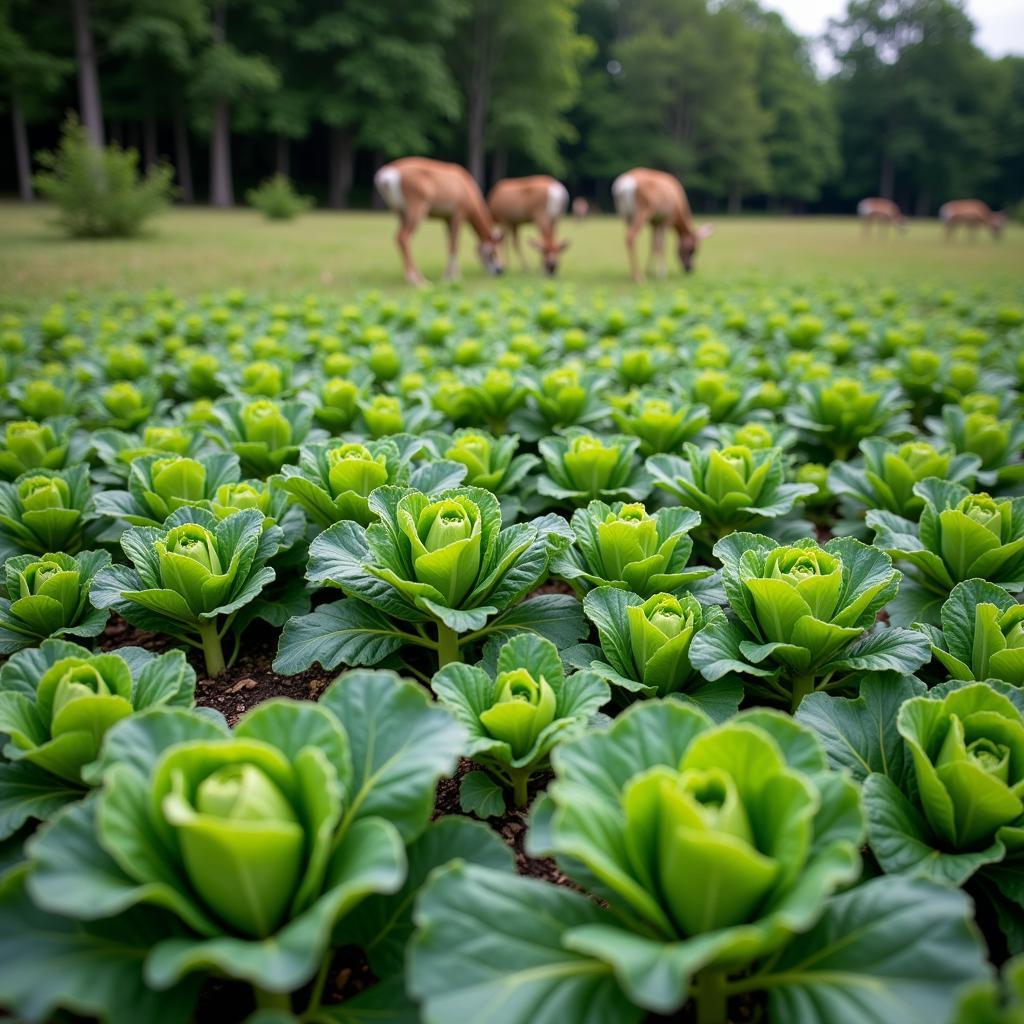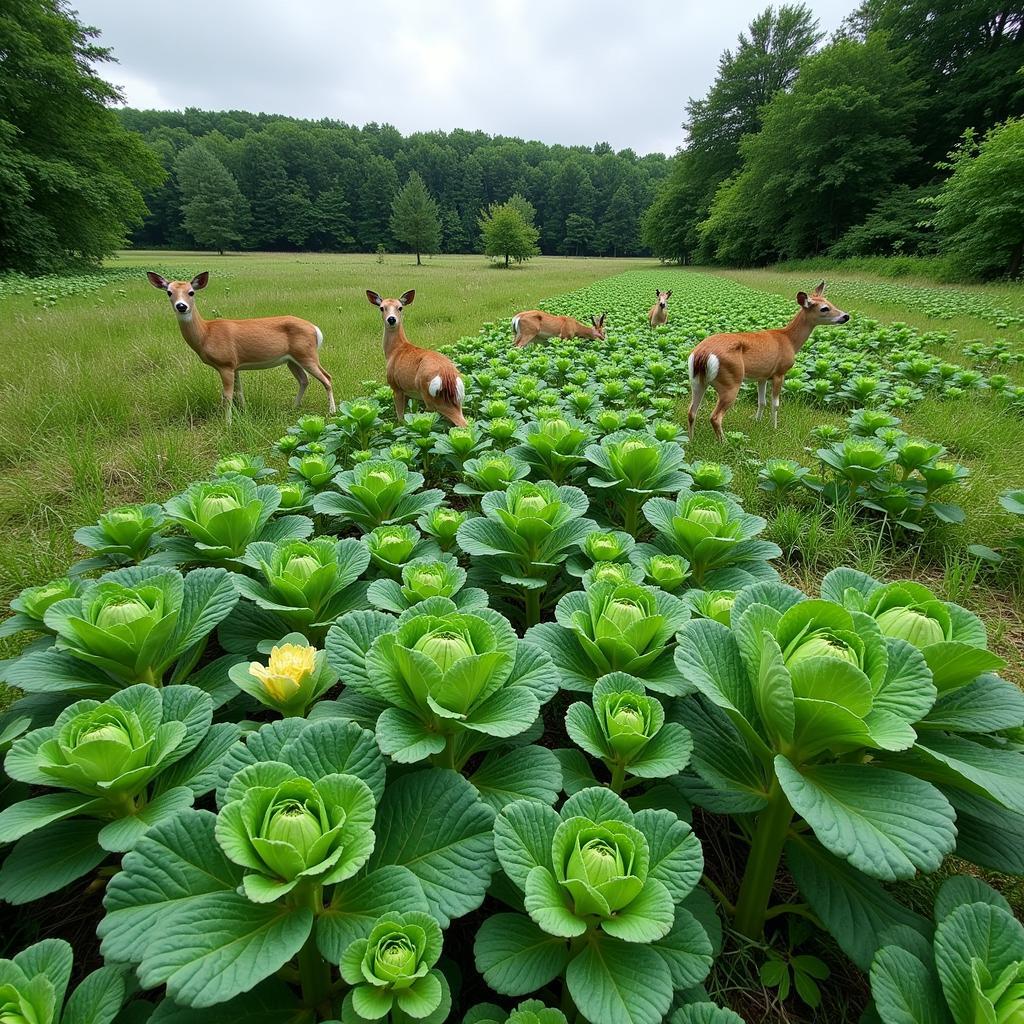Choosing the right food plot seed is crucial for attracting wildlife to your land and providing them with the sustenance they need, especially during lean months. And when it comes to highly attractive and nutritious options, brassicas reign supreme. These cool-season powerhouses are packed with nutrients and offer a delicious variety that keeps deer coming back for more. But with so many brassica food plot seed mixes on the market, how do you choose the best one for your needs? This guide will cover everything you need to know about selecting, planting, and maintaining a thriving brassica food plot.
 Deer in a lush brassica food plot
Deer in a lush brassica food plot
Understanding the Allure of Brassicas for Wildlife
Brassicas, which include plants like turnips, radishes, and kale, are a favorite of deer and other wildlife for several reasons:
- High Nutritional Value: Brassicas are incredibly nutritious, boasting high levels of protein, vitamins, and minerals that are essential for healthy growth and antler development, particularly during late fall and winter.
- Palatability: Deer find the leafy greens and bulbs of brassicas highly palatable. They offer a diverse and tasty food source compared to other forage options.
- Cold Tolerance: Unlike many food plot options that wither in cold weather, brassicas thrive in cooler temperatures and can even withstand light frosts, providing a valuable food source when other options are scarce.
Choosing the Right Brassica Food Plot Seed Mix
Selecting the right seed mix is the foundation for a successful brassica food plot. Here are some factors to consider:
1. Your Region and Climate
Different brassica varieties thrive in different regions. Consider your local climate, including the average frost dates and growing season length, when choosing a seed mix. Look for mixes specifically formulated for your region, ensuring the included varieties are well-suited to your area’s specific growing conditions.
2. Soil Type
Brassicas prefer well-drained soil with a slightly acidic to neutral pH. Conduct a soil test to determine your soil’s pH level and nutrient content. This information will help you select a seed mix that is compatible with your soil type and identify any necessary amendments to create optimal growing conditions.
3. Wildlife Goals
Are you hoping to attract deer, turkey, or other wildlife? Different brassica mixes cater to the preferences of different animal species. If you’re specifically targeting deer, look for mixes containing a higher percentage of turnips, radishes, and rape.
4. Planting Time
Brassicas are typically planted in the late summer or early fall. However, specific planting dates vary depending on your location. Choose a seed mix that aligns with your desired planting window and local climate conditions. Check seed packets for recommended planting dates for your region.
 Testing soil pH for brassica food plot
Testing soil pH for brassica food plot
Planting Your Brassica Food Plot
Once you’ve chosen the Best Brassica Food Plot Seed mix for your needs, it’s time to get planting! Follow these steps:
- Prepare the Seedbed: Just like any garden bed, a well-prepared seedbed is essential for successful germination. Clear the area of any existing vegetation, then till or disc the soil to loosen it up and create a fine, crumbly texture.
- Amend the Soil: Based on your soil test results, incorporate any necessary soil amendments like lime to adjust pH or fertilizer to boost nutrient levels.
- Sow the Seeds: Follow the seeding rate recommendations on your chosen seed mix. It’s crucial to plant the seeds at the correct depth, typically around 1/4 to 1/2 inch deep. You can broadcast the seeds by hand or use a seed spreader for more even distribution.
- Rake and Tamp: After sowing, lightly rake the area to ensure good seed-to-soil contact. Gently tamp down the soil to secure the seeds in place.
- Water Consistently: Consistent moisture is key for successful germination. Water the plot thoroughly after planting and keep the soil consistently moist throughout the germination period. Once established, brassicas are relatively drought-tolerant.
Maintaining Your Brassica Food Plot
With proper maintenance, your brassica food plot will thrive and attract wildlife throughout the fall and winter:
- Monitor for Pests and Diseases: Keep an eye out for any signs of pests or diseases. Early detection is crucial for effective management.
- Control Weeds: Weeds can quickly choke out your brassicas. Employ weeding strategies like hand-pulling or using herbicides specifically labeled for use in food plots.
- Consider a Fall Fertilizer Boost: If you’re in an area with a longer growing season, consider applying a light nitrogen-rich fertilizer in the fall to promote continued growth and forage production.
 A thriving brassica food plot attracting deer
A thriving brassica food plot attracting deer
Brassica Food Plot FAQs
1. When is the best time to plant a brassica food plot?
The optimal planting time for brassicas varies depending on your location. Generally, it’s best to plant in late summer or early fall, about 6-8 weeks before the first frost is expected. This timing allows the plants to establish themselves before the cold weather sets in.
2. Can I plant brassicas with other food plot species?
Yes, brassicas can be successfully planted with other food plot species to create a diverse and attractive food source for wildlife. Popular companion plants include clovers, winter peas, and cereal grains like oats or rye.
3. Do I need to fertilize my brassica food plot?
A soil test is the best way to determine if your food plot needs fertilizer. Brassicas benefit from fertile soil, so if your soil test reveals any nutrient deficiencies, amending the soil with a balanced fertilizer is recommended.
4. How long does it take for brassicas to mature?
Most brassica varieties mature in approximately 90-100 days. However, this can vary depending on the specific variety and growing conditions.
5. How can I prevent deer from overgrazing my brassica food plot?
While brassicas are a highly attractive food source, it’s essential to prevent overgrazing to ensure the long-term health of your plot. Strategies include:
- Planting a larger food plot: Providing ample forage can help reduce grazing pressure.
- Creating multiple smaller food plots: Establishing several smaller plots in different locations can distribute deer grazing.
- Implementing rotational grazing practices: If you have multiple plots, consider fencing off sections and rotating deer access to allow for regrowth.
Conclusion
Planting a brassica food plot is a rewarding endeavor for any landowner passionate about attracting and supporting wildlife. By carefully selecting the best brassica food plot seed for your region, preparing your soil properly, and following essential planting and maintenance practices, you can create a thriving food source that will keep deer and other wildlife coming back for more. Remember, a well-maintained brassica food plot not only benefits wildlife but also enhances the biodiversity and ecological balance of your property.
Need help choosing the perfect seed mix for your needs? Contact us today! We’re here to help you create a thriving brassica food plot. Call us at 02437655121, email us at [email protected], or visit us at 3PGH+8R9, ĐT70A, thôn Trung, Bắc Từ Liêm, Hà Nội, Việt Nam. Our team is available 24/7 to assist you.